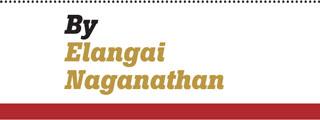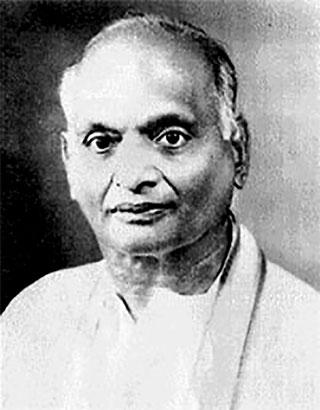Reply To:
Name - Reply Comment
He was also instrumental in introducing the Federal concept as the political solution for the Tamil speaking people
As a young man Dr. Naganathan obtained his M.B.B.S. medical degree at Madras Medical College, and completed his M.R.C.S. and L.R.C.P. postgraduate medical degrees at Guy’s Hospital, London
 Dr. E.M.V.Naganathan, former Member of Parliament for Nallur and Senator (member of the senate or upper house of parliament) was one of the founding members of the Ilankai Thamizh Arasu Katchi (ITAK) or the Federal Party along with Mr.S.J.V.Chelvanayakam better known as Thanthai Chelva, and Mr. C.Vanniasingham, in December 1949. He was often referred to as the “Irumbu Manithan” or Iron Man of the party. He was born in (Madras) now Chennai on January 31, 1901, and died on August 16, 1971 in his 70th year. It is now 50 years since his death and in this article we look back at his life and his contribution to the political history of the Tamil people. The heroism and dedication of the non violent Satyagraha struggle for the rights of the Tamil speaking people should not be forgotten. Dr.Naganathan was one of the leaders of that struggle. He was also instrumental in introducing the Federal concept as the political solution for the Tamil speaking people. As the ideologue of the party, he wrote pamphlets and articles to disseminate the Federal idea.
Dr. E.M.V.Naganathan, former Member of Parliament for Nallur and Senator (member of the senate or upper house of parliament) was one of the founding members of the Ilankai Thamizh Arasu Katchi (ITAK) or the Federal Party along with Mr.S.J.V.Chelvanayakam better known as Thanthai Chelva, and Mr. C.Vanniasingham, in December 1949. He was often referred to as the “Irumbu Manithan” or Iron Man of the party. He was born in (Madras) now Chennai on January 31, 1901, and died on August 16, 1971 in his 70th year. It is now 50 years since his death and in this article we look back at his life and his contribution to the political history of the Tamil people. The heroism and dedication of the non violent Satyagraha struggle for the rights of the Tamil speaking people should not be forgotten. Dr.Naganathan was one of the leaders of that struggle. He was also instrumental in introducing the Federal concept as the political solution for the Tamil speaking people. As the ideologue of the party, he wrote pamphlets and articles to disseminate the Federal idea.
Although Dr.Naganathan’s ancestral home was Arasakesari Valavu, Sankilithoppu in Nallur, he grew up largely in Madras, India where his father, John Jebaretnam Hensman held an administrative position in the Madras University. He was educated at Madras Christian College School. He played cricket and hockey for Tamil Union, which was his main sports club. He was also an active member of the Y.M.C.A. He was gifted with a golden tenor voice and delighted in singing the famous Italian operas.
 As a young man Dr. Naganathan obtained his M.B.B.S. medical degree at Madras Medical College, and completed his M.R.C.S. and L.R.C.P. postgraduate medical degrees at Guy’s Hospital, London, where he earned a gold medal for surgery. He returned to Sri Lanka where he opened his successful private medical practice at 79, Galle Road, Colombo 4, as a general family practitioner. He married Retnavathi , daughter of John Wirt Ponniah Senathirajah from Alaveddy Jaffna in 1932, and together they became the parents of five children, Lakshmi, Elangai, John, Nirmala and Indhira.
As a young man Dr. Naganathan obtained his M.B.B.S. medical degree at Madras Medical College, and completed his M.R.C.S. and L.R.C.P. postgraduate medical degrees at Guy’s Hospital, London, where he earned a gold medal for surgery. He returned to Sri Lanka where he opened his successful private medical practice at 79, Galle Road, Colombo 4, as a general family practitioner. He married Retnavathi , daughter of John Wirt Ponniah Senathirajah from Alaveddy Jaffna in 1932, and together they became the parents of five children, Lakshmi, Elangai, John, Nirmala and Indhira.
Dr.Naganathan’s interest in politics was inspired by idealism. He was instinctively bound up with a feeling of empathy for the underprivileged or underdog in any given situation. He initially joined the All Ceylon Tamil Congress (ACTC) founded in August 1944 by G.G.Ponnambalam and was for a time the general secretary of the party. He was appointed to the Senate in 1947 representing the ACTC.
Subsequently Dr. Naganathan along with S.J.V. Chelvanayakam and C.Vanniasingham became the founder members of the Federal Party or Ilankai Thamil Arasu Katchi (ITAK), in December 1949. The formation of the new party was in the context of the passing of the Citizenship Acts which disenfranchised the Malayaha Tamils of the central highlands who were working on the tea plantations. The Tamil Congress voted with the UNP Government and the members who opposed this i.e the above three members left the Tamil Congress to form the Federal party. Dr. Naganathan was ITAK’s general secretary for a period and became the party’s president in 1966. He was the ITAK’s candidate for Nallur at the March 1960 parliamentary election. He won the election and entered the lower house of Parliament. He was re-elected at the July 1960 and 1965 parliamentary elections.
Dr. Naganathan was greatly impressed by the example of the Swiss Federation which had been established in 1848. Looking for a political and constitutional settlement that would satisfy both sets of nationalistic criteria both Sinhala and Tamil, it was Federalism that struck him convincingly as the best solution.
In this context the concept of parity was foremost in his consciousness. It was not so much a question of equality, as that term connoted a quantitative dimension. In Dr. Naganathan’s view, it was more a question of the two peoples in this case the Sinhalese and the Tamils being on a par with one another in their relationship with each other.
He was instinctively bound up with a feeling of empathy for the underprivileged or underdog in any given situation. He initially joined the All Ceylon Tamil Congress (ACTC) founded in August 1944 by G.G.Ponnambalam and was for a time the general secretary of the party
Dr. Naganathan felt that the Swiss Federation constitution drew on the ideas and experiences of the two most progressive nations of the world at that time namely the USA and the French Republic. Sadly, Tamil leadership of the 1940s, when the Soulbury constitution was being drafted, did not recognise or draw useful lessons from the Swiss experience. The new Swiss constitution of 1848 was accepted by a majority of 15 1/2 cantons, with 6 cantons opposing, and was declared to be legal in September 1848.
The years between 1949 and 1970 was a period of great trauma for Tamils of Sri Lanka as a result of the enactment of the Citizenship Acts of 1948 and 1949, and the Sinhala Only Act No.33 of 1956. The former was the work of the United national party government and the latter of the SLFP and MEP. It was the passing of the Citizenship Acts and disenfranchisement of the Upcountry Malayaha Tamils that grieved Dr. Naganathan. The enactment of Sinhala as the only official language of the country was met with great anguish from the Tamil speaking people. The demonstrations against the Sinhala Only Act by the Tamils under the leadership of the Federal party, introduced for the first time the Satyagraha concept and method of political campaigning based on the Gandhian model. The first demonstration consisted of a Satyagraha on June 5, 1956 on the Galle Face Green outside the Parliament building in which Dr. Naganathan participated along with Chelvanayakam, Vanniasingham and other MP’s of the federal party along with other supporters both Tamil and Muslim. The Satyagrahis were beaten by an extremist Sinhala mob while the police looked on. Some of them were thrown into the Beira Lake. The Sinhalese nationalist group organised a counter-protest and a mob representing this group attacked the Tamil protesters and was “responsible for unleashing riots that killed nearly 150 Tamil speaking people and caused the first displacement of these communities out of areas in the south.
Prime minister Bandaranaike subsequently came to an agreement with the Federal party in the Bandaranaike-Chelvanayakam pact which provided for reasonable use of Tamil and regional councils in the North and East. When this pact was scuttled by the opposition UNP and the Sinhala extremist parties, followed by the assassination of the Prime Minister Bandaranaike by extremist elements the Federal party had to once again go back to its non violent campaign of opposition to the Government policies. The next phase of this movement was the civil disobedience campaign inaugurated in 1961. It developed into Satyagrahas before government offices in all the Northern and Eastern provinces including Mannar, Trincomalee, Vavuniya and Batticoloa. There was great enthusiasm among the Tamil speaking people and men women and even school children participated. The Muslims in Jaffna and the Eastern province too participated. As the administration in these provinces had broken down, the Government instead of coming to a negotiated settlement instead sent in the armed forces and on April 20,1961 declared an Emergency.
Dr. Naganathan was greatly impressed by the example of the Swiss Federation which had been established in 1848. Looking for a political and constitutional settlement that would satisfy both sets of nationalistic criteria both Sinhala and Tamil, it was Federalism that struck him convincingly as the best solution
During this period the North and East were under emergency regulations, a curfew, censorship of the press, disorganisation of the postal and telephonic services and the cutting of communications with the rest of the world. Dr. Naganathan was also held in detention at the Panagoda army camp. He had been one of the leaders and was associated with the Satyagraha movement at every stage both in its first phase 1956 - 58 and in the second phase 1961. He played a leading role in the Satyagraha at the Jaffna Kachcheri in old Park of 20th February 1961 and was baton charged along with Mr. A.Amirthalingam. The police baton charged the protestors, kicking and dragging them away. Several protestors, including ITAK MPs A. Amirthalingam, V. Dharmalingam, V. A. Kandiah, E. M. V. Naganathan and K. Thurairatnam were injured. The police fired tear gas to disperse a large crowd that had gathered to watch the Satyagraha. It was then that an unusual incident occurred. When a policeman rained blows on Dr. Naganathans head, Inexplicably the baton broke. Later Naganathan was to take the broken baton piece home as a souvenir. The incident created a popular image for Naganathan among Tamils. He was eulogised as “Irumbu Manithan” or ‘Iron Man’ thereafter.
Dr. Naganathan always made it abundantly clear that he loved and respected the Sinhala people as compatriots, and only wished to achieve equal status and opportunities for the Tamil speaking citizens of Sri Lanka, by non-violent protests, peaceful demonstrations and political negotiations in good faith, in the best traditions of the Indian Independence Movement by which he was greatly inspired as a young man. Dr. Naganathan will remain evergreen among those who cherish the right of the minority to equality and parity of status, and who value peace, harmony and goodwill between peoples of different communities and backgrounds residing in their traditional regions in the same beloved homeland.